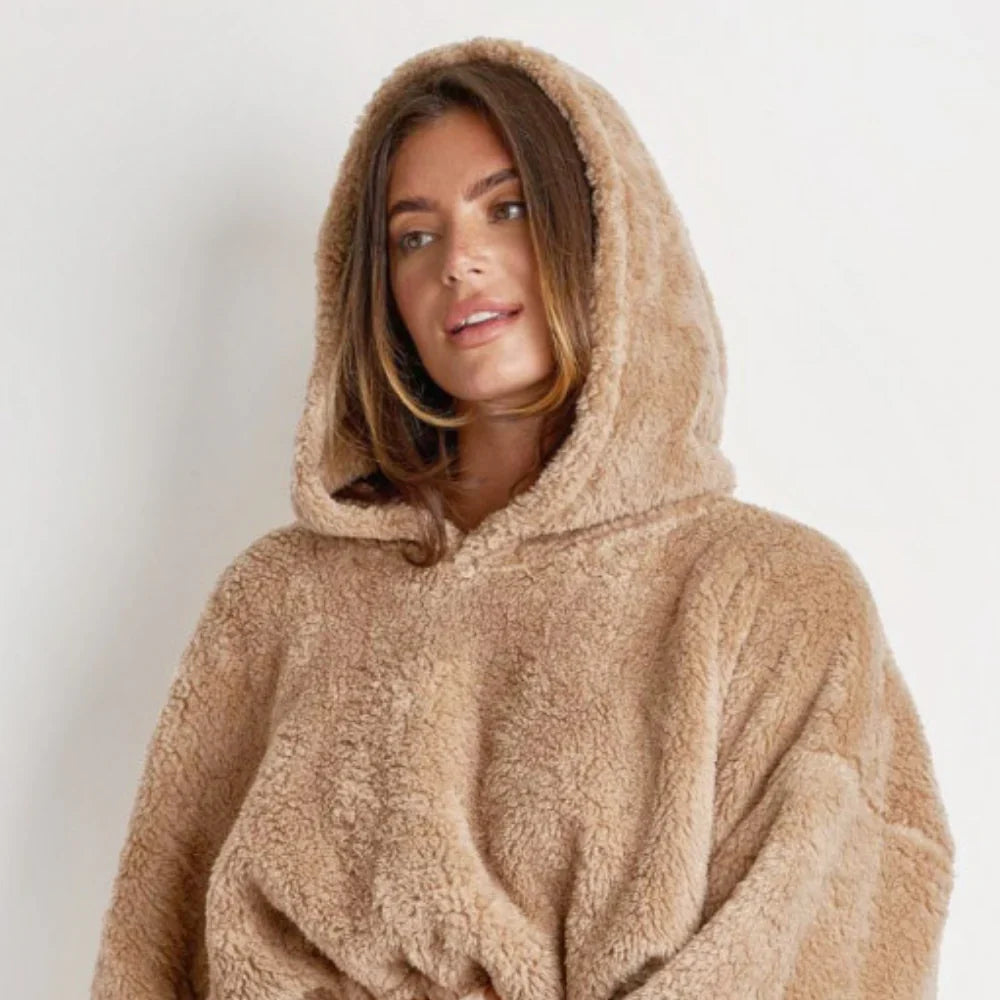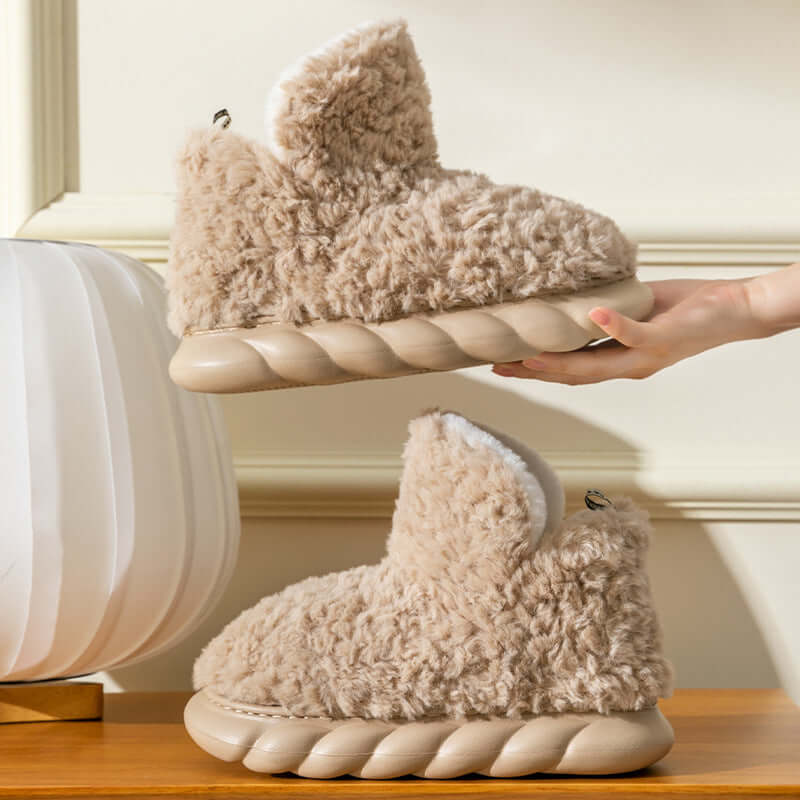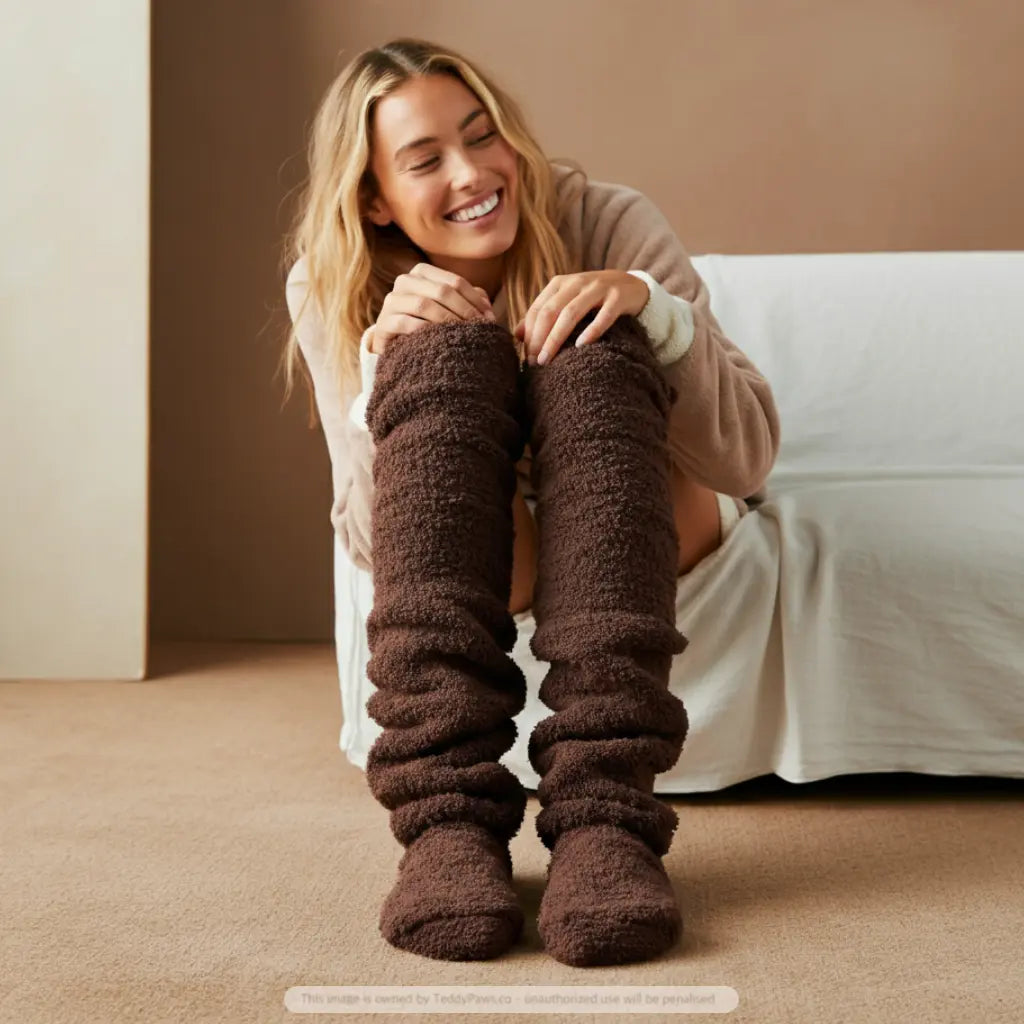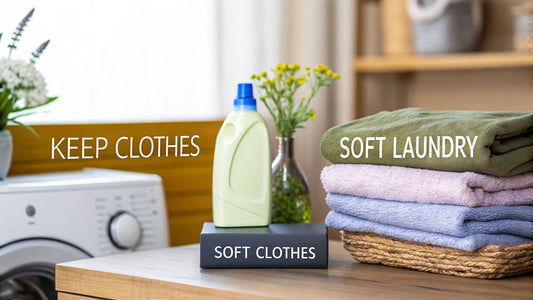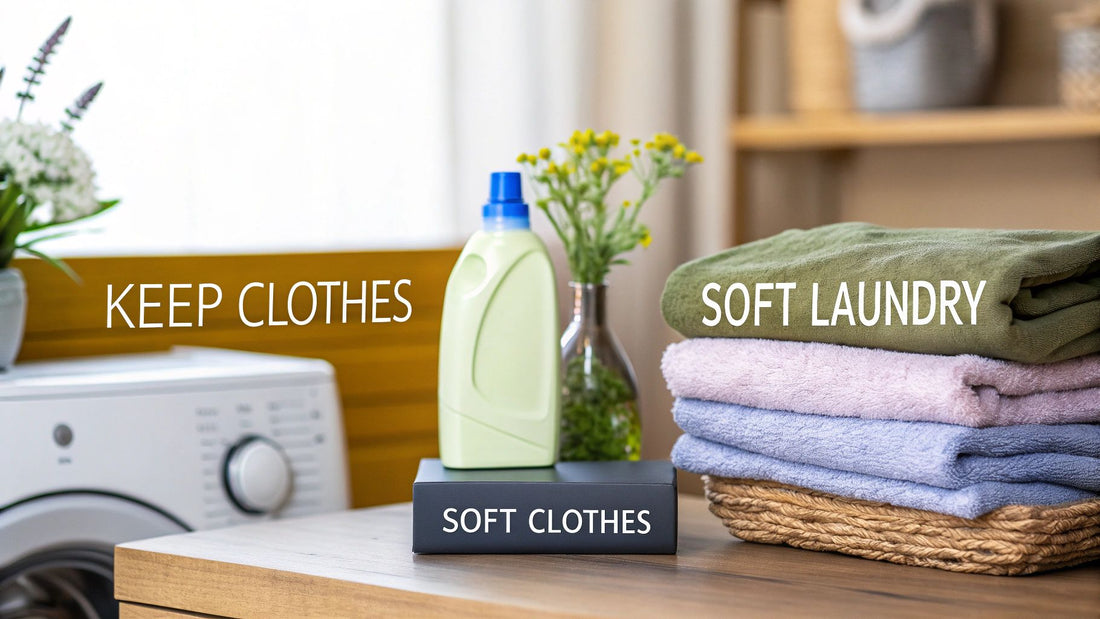
How to Keep Clothes Soft: Your Ultimate Laundry Guide
Share
Tired of your favorite clothes feeling stiff and scratchy? The secret isn't more products—it's fixing what's causing the problem in the first place: hard water mineral buildup, damaging dryer heat, and stubborn detergent residue. Don't wait for your fabrics to wear out. A few immediate changes to your laundry routine—like turning down the heat, using the right amount of soap, and adding a natural softener like vinegar—can bring back that brand-new feel today.
Why Your Clothes Are Losing Their Softness
Ever notice how that unbelievably soft hoodie gets progressively stiffer with every wash? That slow transformation from cloud-like comfort to a rough, almost crunchy texture is happening right in your laundry room. Identifying the culprits is the only way to reverse the damage and reclaim that softness.
The biggest offender is something you can't even see: hard water. A staggering 85% of US homes have it, and it’s loaded with minerals like calcium and magnesium. With every wash, these minerals latch onto fabric fibers, leaving behind a stiff coating that just keeps building up.
Imagine a tiny suit of armor forming on every thread, making it impossible for the fabric to feel soft against your skin. You have to break it down.
The Unseen Damage from Your Laundry Routine
But it's not just the water. Your everyday laundry habits could be making things much worse. A classic mistake? Using too much detergent. Thinking more soap means cleaner clothes is a myth. The extra suds don't rinse out completely, leaving behind a sticky film that makes fabric stiff and actually attracts more dirt.
And then there's the dryer. Blasting your laundry on high heat is like baking the softness right out of the fibers, leaving them brittle and harsh. This heat damage is permanent and a fast track to ruining the texture you love. It's also what causes those annoying little fuzzballs—learn more in our guide on what causes fabric pilling.
The combination of mineral deposits, soap residue, and high heat creates a perfect storm for stiff, uncomfortable laundry. Each wash cycle can either restore softness or contribute to the problem.
To learn how to keep clothes soft, you have to get to the root of the problem. Make a few small, targeted changes to how you do laundry, and you can stop this cycle of damage and start bringing your favorite clothes back to life, one load at a time.
Transform Your Wash Cycle for Softer Fabrics
The journey to softer, cozier clothes starts right now, in your washing machine. Forget about complicated formulas or pricey treatments. Making a few intentional tweaks to your wash routine will make a massive difference, protecting those delicate fabric fibers from the start.
One of the most common mistakes is using too much detergent. It seems counterintuitive, but more soap doesn't mean cleaner clothes—it means more residue. This leftover film clings to fibers, making them feel stiff and sticky. Actionable step: Cut your usual amount of detergent by about a third and feel the difference for yourself.
Give Your Laundry a Natural Boost
For a powerful, gentle alternative to chemical softeners, just head to your pantry. Adding a half-cup of distilled white vinegar to the rinse cycle is an absolute game-changer. The acetic acid in vinegar is fantastic at dissolving mineral buildup from hard water and stripping away lingering detergent residue that’s making your clothes stiff.
Don't worry about the smell! It rinses out completely, leaving your fabrics naturally soft and even more absorbent. This is the secret weapon for reviving crunchy towels and stiff cotton shirts.
The infographic below nails down the main culprits that are sabotaging your fabric's softness.
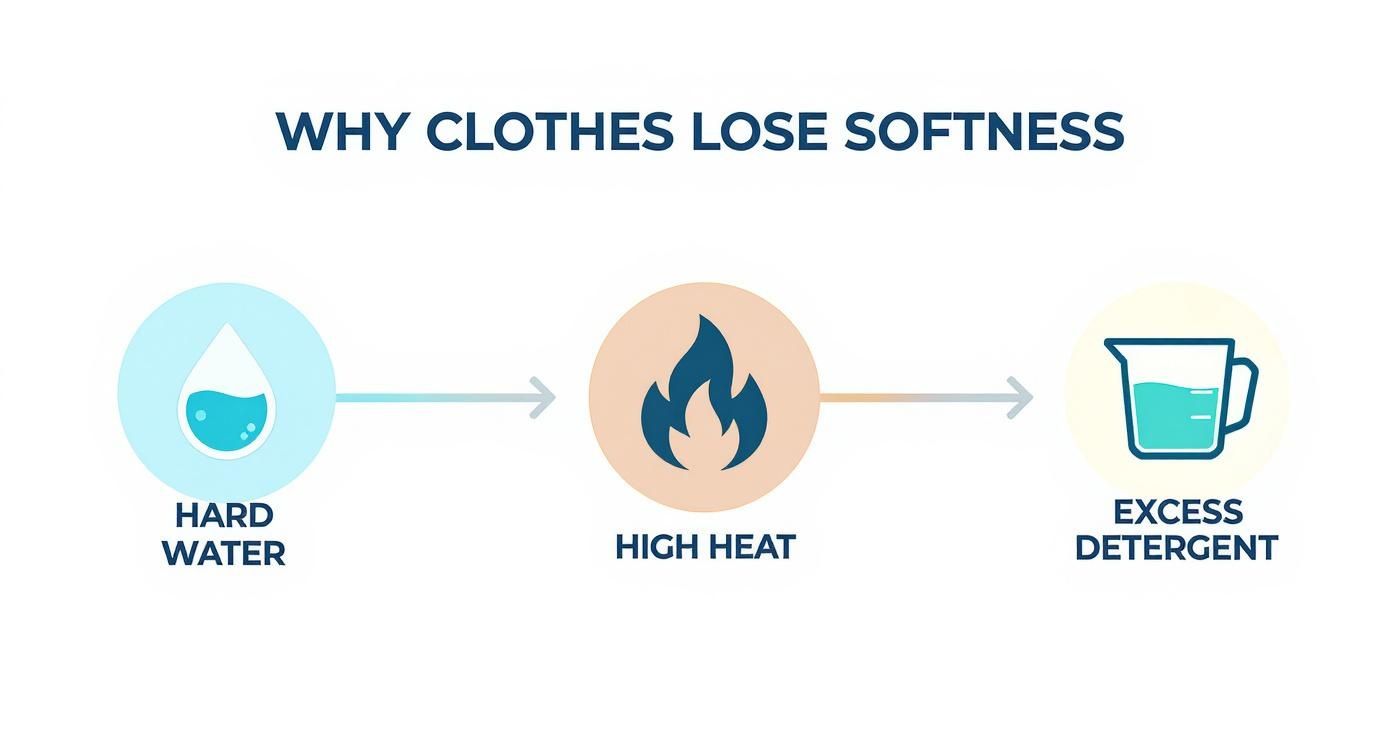
As you can see, it's that combination of hard water, too much heat, and excess detergent that works against you. This is exactly why these targeted changes to your wash cycle are so critical.
Rethink Your Water Temperature and Product Choices
Another huge factor is water temperature. While hot water is great for sanitizing, it’s harsh on fabric fibers, causing them to break down and feel rough. For most of your laundry, washing in cold water is the superior choice. It's gentler on your clothes, helps prevent shrinking and fading, and is far more energy-efficient.
When you do grab a commercial softener, choose wisely. The fabric softener market, valued at a massive USD 15.31 billion in 2024, is shifting toward sustainability. Consumers are demanding eco-friendly, plant-based formulas with ingredients like aloe vera that are kinder to fabrics and sensitive skin. Get more insights on this growing trend from Data Bridge Market Research.
For a clearer picture, let's break down your options.
Comparing Your Fabric Softening Options
This head-to-head comparison will help you decide between natural and commercial softeners for your next laundry load.
| Softening Agent | How It Works | Ideal For | Things to Consider |
|---|---|---|---|
| Distilled White Vinegar | Dissolves mineral buildup and detergent residue, relaxing fabric fibers. | Towels, cottons, workout clothes, and baby clothes. Great for sensitive skin. | The smell dissipates during the rinse cycle, but add it during the rinse, not with detergent. |
| Baking Soda | Softens water and helps regulate the pH level, preventing stiffness. | Brightening whites and neutralizing odors along with softening. | Use about a half-cup directly in the drum before adding clothes. |
| Liquid Fabric Softener | Coats fibers with lubricating chemicals to reduce static and add softness. | Synthetic fabrics like polyester and fleece where static is a problem. | Can reduce towel absorbency and may irritate sensitive skin. Not ideal for athletic wear. |
| Dryer Sheets | Transfers softening agents to fabrics via heat and tumbling action. | Quick and convenient for reducing static cling in most fabrics. | Can leave a residue on your dryer's lint screen and in the machine itself. |
Ultimately, whether you choose a pantry staple or a store-bought product depends on your fabrics, your skin sensitivity, and your personal preference.
Key Takeaway: The secret to a softness-preserving wash cycle is simple—use less detergent, add white vinegar to the rinse, and wash with cold water.
These straightforward steps turn your washing machine into your best ally in the quest for lasting softness. It's not about adding more products, but about washing smarter. By doing so, you'll keep your fabrics plush and comfortable for years to come. Your favorite TeddyPaws hoodie will thank you for it.
Choosing Products That Deliver Real Softness

Let's be honest, the laundry aisle can be overwhelming. But making the right choice here is one of the fastest ways to get the softness you're after. If you want a real difference you can feel, it’s time to upgrade your laundry arsenal. Stop grabbing the same old bottle out of habit; look for products that actively protect and condition your fabrics.
People are switching to plant-based and hypoallergenic formulas for good reason. These gentler options skip the harsh chemicals that build up on fibers, which not only irritate sensitive skin but also make things like towels less absorbent over time.
Your Essential Softening Toolkit
To get that plush, cozy feel, you need to know what each product actually does. They aren’t interchangeable, and using them strategically is what gets you that high-end, super-soft result. Think of it as building your laundry dream team.
Here's what your modern laundry toolkit should look like:
- Liquid Fabric Softener: This is your deep conditioner. It works during the rinse cycle to deposit lubricating agents right onto the fibers, making them feel slick and smooth. It’s a workhorse for fighting wrinkles and adding that fresh-out-of-the-laundry scent.
- Dryer Sheets: The MVP for battling static cling. As your clothes tumble, the dryer's heat activates the softening agents, which transfer to the fabric. The result? Static-free, lightly scented clothes every time.
- Wool Dryer Balls: A reusable and chemical-free powerhouse. These guys physically pummel the fabric as they dry, separating clothes to boost airflow. This cuts down on drying time and softens fibers naturally without leaving behind any residue. A must-have for an eco-friendly routine.
By selecting the right products, you're not just cleaning your clothes—you're actively preserving their texture and extending their life. This small change makes a massive difference you can feel instantly.
The global fabric softener market is booming and on track to hit USD 43.8 billion by 2035. That incredible growth is fueled by people just like you demanding more from their laundry care—products that don't just clean, but also soften, freshen, and protect. Dig into this trend and see how consumer awareness is shaping the market over at Future Market Insights.
Master Your Drying Routine for a Fluffy Finish
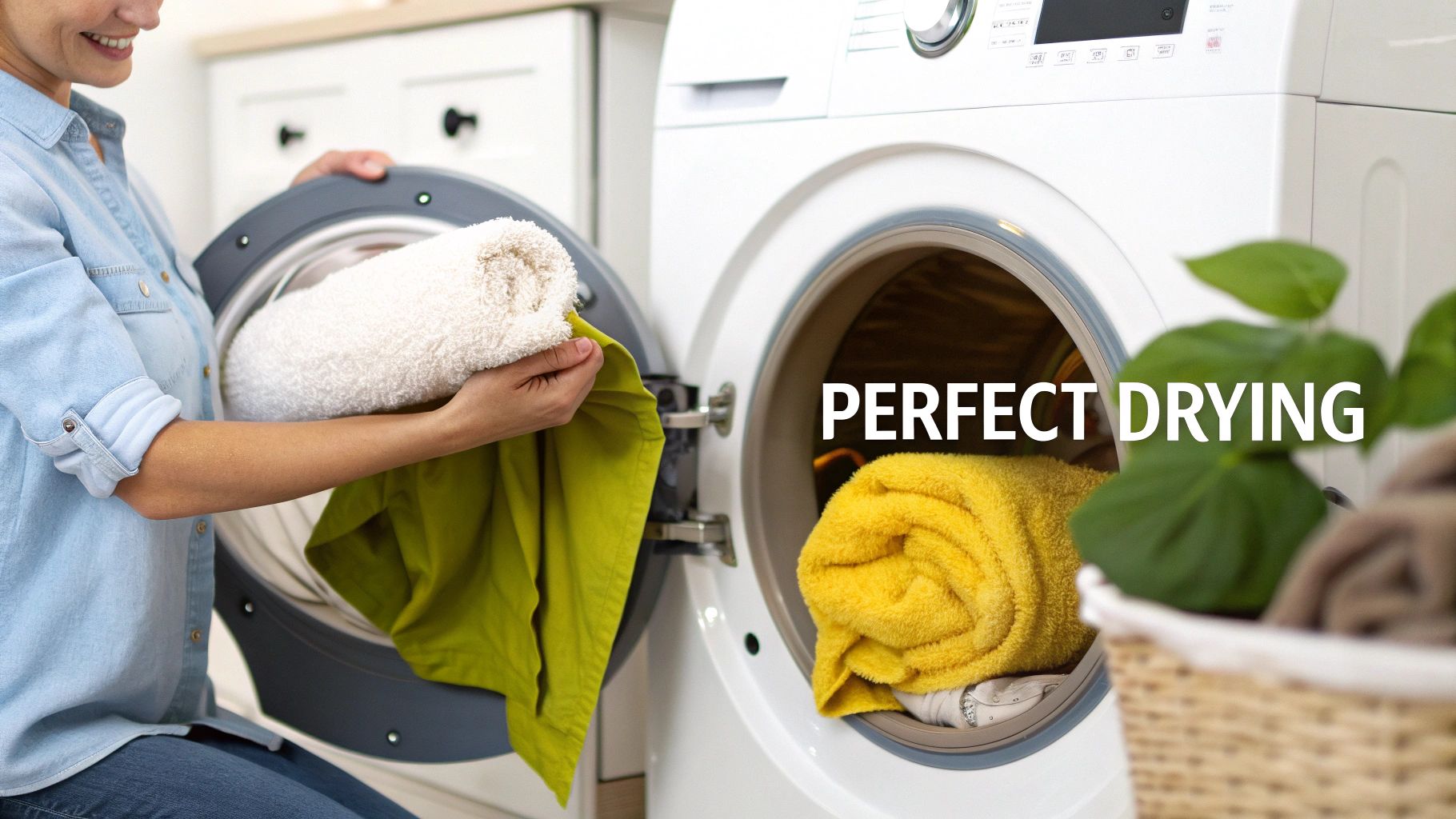
Don't let all that effort in the wash cycle go to waste in the dryer. This is where you lock in that perfect, fluffy finish—or accidentally cook the fibers, leaving them stiff and brittle. The dryer can be your fabric's worst enemy if you're not careful.
The single most important rule? Turn down the heat. Blasting your clothes on high might feel faster, but it’s causing serious, irreversible damage. A low or medium heat setting is always the smarter play, gently drying your clothes while keeping their natural softness intact.
Before you toss your laundry in, give each piece a good, solid shake. This simple move is a game-changer. It helps separate and fluff up the fibers, preventing wrinkles and getting air flowing for a more even, noticeably softer result.
Upgrade Your Drying Tools
To level up your laundry game, it’s time to rethink what goes into the dryer with your clothes. Invest in a set of wool dryer balls. They bounce around in the machine, physically separating clothes and pummeling them into a state of fluffiness.
Because they keep everything from clumping, they boost air circulation in a big way, which can reduce drying time by up to 25%. Less time in the heat means softer clothes and a lower energy bill.
While dryer balls soften fabrics naturally, dryer sheets are still popular for that final touch of scent and static control. It's a massive market—valued at USD 21.37 billion in 2024—which shows just how popular they are. While effective, be aware they can leave a waxy residue on fabrics and your lint trap.
Pro Tip: If you're still getting static zaps even after using dryer sheets, it’s a sign of over-drying. Our guide on how to remove static from clothes has extra tricks to solve that annoying problem for good.
The Art of Air-Drying Without Stiffness
Hate that cardboard-like feeling from air-drying? You can avoid it. The trick is to stop the fabric fibers from bonding together too tightly as they dry.
Just like with machine drying, a vigorous shake before hanging your clothes is essential. If you can, hanging them outside on a breezy day helps mimic the tumbling motion of a dryer, keeping them loose and soft.
And one final thought: a clean dryer is an efficient dryer. A machine clogged with lint won’t work as well and can easily overheat, leading to stiff fabrics. Following a good DIY dryer air duct cleaning guide will keep things running smoothly for perfectly soft results every time.
Next-Level Care: Stop Ruining Your Clothes With One-Size-Fits-All Laundry
Throwing everything into the same wash cycle is a recipe for disaster. What works wonders for tough jeans will destroy a delicate blouse. If you want to keep your entire wardrobe feeling soft and looking new, you have to stop the one-size-fits-all laundry routine.
Ignoring a fabric’s specific needs is the fastest way to turn a favorite shirt into a stiff, scratchy mess. Let's get into the details for some of the most common materials in your closet.
A Gentle Touch for Delicates and Synthetics
Fabrics like silk, rayon, and modern athletic wear are sensitive. They need a gentle hand to prevent permanent damage. Their number one enemy? High heat. It can literally melt or warp synthetic fibers, leaving them feeling rough and brittle forever.
For these items, action is required: always use a cold-water wash on the most delicate cycle. When it's time to dry, your best bet is to air-dry them away from direct sunlight. If you must use a machine, stick to a no-heat or "air fluff" setting for just a few minutes to soften them without the risk.
Bringing Denim and Towels Back to Life
Have your jeans and towels gotten stiff over time? That’s due to detergent buildup and over-drying. The secret to soft denim is simple: wash them inside out in cold water and use about half the detergent you normally would. Skip the fabric softener—it breaks down denim fibers.
As for those crunchy towels, that's a sure sign of residue. Bring them back from the brink with this trick:
- Run a hot water cycle with one cup of white vinegar. Do not add any detergent.
- Immediately run another hot cycle, this time with half a cup of baking soda (again, no detergent).
This one-two punch strips away that stiff, filmy buildup and instantly restores their fluffiness. It’s a simple step that can save your towels from becoming scratchy and useless.
This same idea of targeted, gentle care works for other natural fibers, too. For example, learning the specifics of washing bamboo sheets for lasting softness is key to keeping them silky smooth. Every fabric has its own rules, and mastering them is how you keep everything you own feeling brand new.
Still Puzzled by Laundry Problems? Let’s Clear Things Up.
Even when you follow the rules, some laundry mysteries persist. If you've ever pulled a rock-hard towel from the dryer or wondered why your air-dried clothes feel like cardboard, you're not alone. Let’s tackle some of the most common questions.
How Do I Get My Stiff, Scratchy Towels Soft Again?
That stiff, crunchy feeling in your towels is almost always a classic case of detergent buildup. The fibers get so caked with residue that they can't fluff up.
The fix is surprisingly simple. First, wash them on a hot cycle with one cup of white vinegar—and no detergent. Then, run them through a second hot cycle, this time with half a cup of baking soda, again with no detergent. This one-two punch strips away all that gunk and brings back their natural softness.
Going forward, use a little less detergent than you think you need. And skip the liquid fabric softener on towels; it adds a waxy layer that ruins their absorbency.
Why Do My Clothes Get So Stiff When I Air-Dry Them?
When you hang your clothes to dry, the water evaporates slowly, causing the tiny fibers in the fabric to stick together and harden. It's a normal process, but it can leave your favorite t-shirt feeling rigid.
The easiest way to fight this is to give each piece of clothing a really good, vigorous shake before you hang it up. This simple motion helps to separate and loosen the fibers so they don't lock up so tightly.
If your clothes are still a little stiff once they're dry, just toss them in the dryer for five minutes on a no-heat "air fluff" setting with a few wool dryer balls. It works like a charm to soften them right up without any heat damage.
Does Fabric Softener Actually Ruin Clothes?
Honestly, it can. Traditional liquid softeners work by coating your fabrics in a waxy, water-resistant film. While that might feel soft initially, that buildup is terrible for certain items.
It's especially bad for towels, as it kills their ability to absorb water, and for your athletic wear, because it clogs the technical fibers designed to wick sweat away.
Many modern, plant-based formulas are designed to rinse away much cleaner. The real key is knowing which products to use on which fabrics. For your towels and gym clothes, a splash of white vinegar is still your safest—and most effective—bet for keeping them soft without sacrificing performance.
Stop settling for stiff, scratchy loungewear. Experience the lasting, cloud-like comfort you deserve with TeddyPaws. Our ultra-soft fabrics are designed to stay plush wash after wash. Shop the collection now and wrap yourself in pure coziness before your favorite styles sell out.

